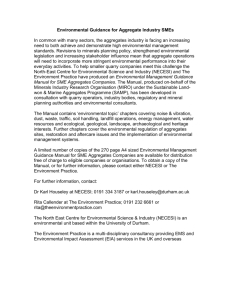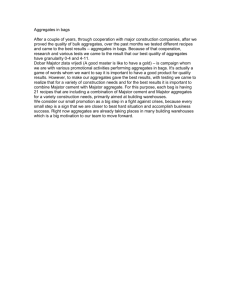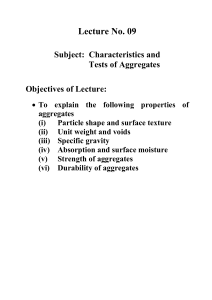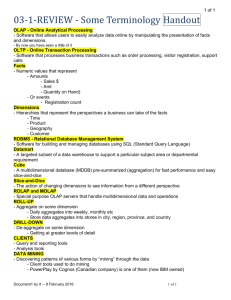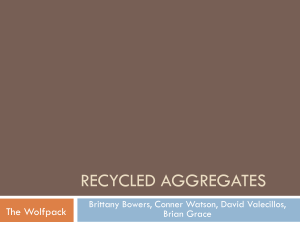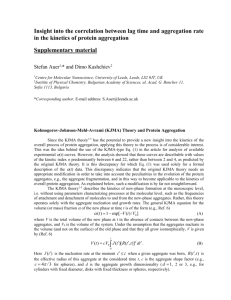Manufactured aggregate as imported backfill material for plastic pipes.
advertisement
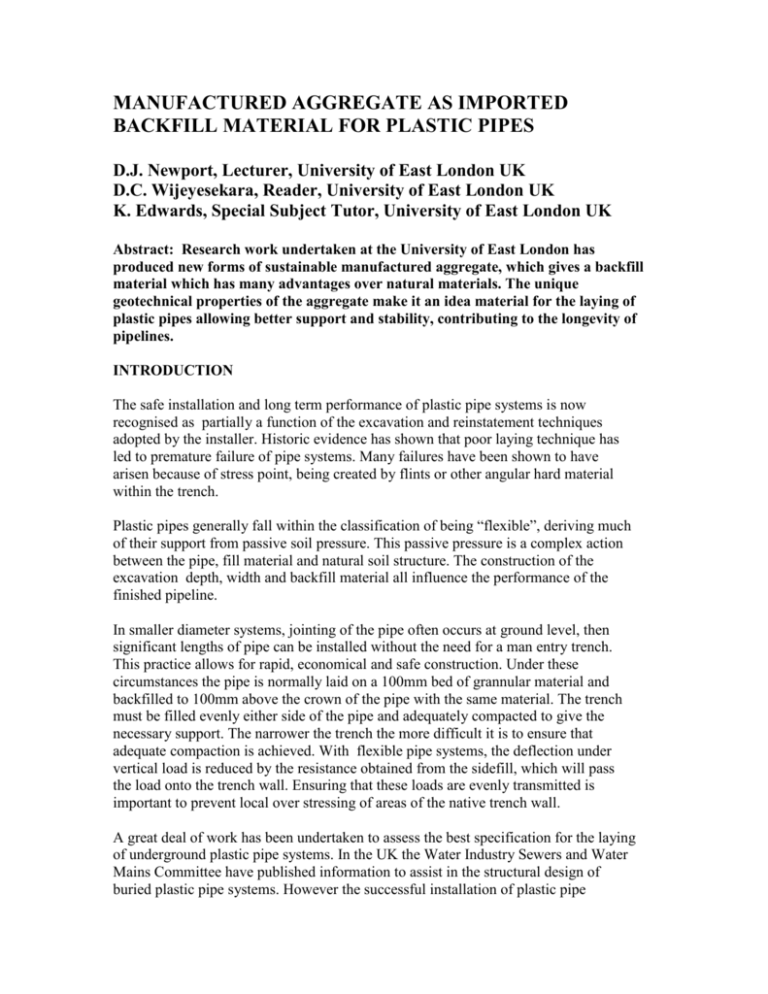
MANUFACTURED AGGREGATE AS IMPORTED BACKFILL MATERIAL FOR PLASTIC PIPES D.J. Newport, Lecturer, University of East London UK D.C. Wijeyesekara, Reader, University of East London UK K. Edwards, Special Subject Tutor, University of East London UK Abstract: Research work undertaken at the University of East London has produced new forms of sustainable manufactured aggregate, which gives a backfill material which has many advantages over natural materials. The unique geotechnical properties of the aggregate make it an idea material for the laying of plastic pipes allowing better support and stability, contributing to the longevity of pipelines. INTRODUCTION The safe installation and long term performance of plastic pipe systems is now recognised as partially a function of the excavation and reinstatement techniques adopted by the installer. Historic evidence has shown that poor laying technique has led to premature failure of pipe systems. Many failures have been shown to have arisen because of stress point, being created by flints or other angular hard material within the trench. Plastic pipes generally fall within the classification of being “flexible”, deriving much of their support from passive soil pressure. This passive pressure is a complex action between the pipe, fill material and natural soil structure. The construction of the excavation depth, width and backfill material all influence the performance of the finished pipeline. In smaller diameter systems, jointing of the pipe often occurs at ground level, then significant lengths of pipe can be installed without the need for a man entry trench. This practice allows for rapid, economical and safe construction. Under these circumstances the pipe is normally laid on a 100mm bed of grannular material and backfilled to 100mm above the crown of the pipe with the same material. The trench must be filled evenly either side of the pipe and adequately compacted to give the necessary support. The narrower the trench the more difficult it is to ensure that adequate compaction is achieved. With flexible pipe systems, the deflection under vertical load is reduced by the resistance obtained from the sidefill, which will pass the load onto the trench wall. Ensuring that these loads are evenly transmitted is important to prevent local over stressing of areas of the native trench wall. A great deal of work has been undertaken to assess the best specification for the laying of underground plastic pipe systems. In the UK the Water Industry Sewers and Water Mains Committee have published information to assist in the structural design of buried plastic pipe systems. However the successful installation of plastic pipe systems requires a great deal of care in the placing and compaction of backfill which necessitates competent and dedicated supervision and quality control. One of the crucial decisions required to ensure effective construction is the choice of bed and surround material. As experience has shown that the wrong material can led to pipeline failure, many installers are using imported granular materials to prevent pipe damage or poor compaction. The consequence of this use of imported material is significant in terms of the need for either quarried or sea dredged materal. This requirement impacts on the environmental costs of transportation and disposal of waste material. AGGREGATE IN THE UK The UK Government has for sometime been concerned about the sustainability of mineral extraction and carefully monitor the amount of aggregate that is used and its sources. Table 1 shows the likely quantity of aggregate to be used in England until the year 2016. The table shows how alternative materials are becoming a very significant contributor to the overall aggregate requirments. Table 1: National And Regional Guidelines For Aggregates Provision In England, 2001 - 2016 (Million Tonnes)1 Guidelines for land-won production Land-won Land-won New Regions Sand & Crushed Gravel Rock South East 212 35 England 19 0 London East of 256 8 England East 165 523 Midlands West 162 93 Midlands 106 453 South West 55 167 North West Yorkshire & 73 220 the Humber 20 119 North East England 1068 1618 Assumptions Marine Sand & Gravel Alternative Net Imports Materials to England 120 118 85 53 82 6 32 110 8 0 95 0 0 88 16 9 4 121 101 4 50 3 128 0 9 230 76 919 0 169 The UK Government is also acutely aware of how the aggregate extraction industry is viewed by the public. It has therefore undertaken research to assess how much the public are willing to pay to reduce significantly the enviromental effects of quarrying. An extract from that report 2 is as follows: “The research was mainly undertaken to inform decisions about the regulation and possible taxation of the aggregates industry. The key results are that, on average, after grossing up from survey results to the whole relevant population: People living near hard rock quarries expressed a willingness to pay of about £10 per year, which is equivalent to around £0.35 per tonne of crushed rock produced. People living near sand and gravel operations expressed a willingness to pay of about £15 per year, which is equivalent to around £2 per tonne of sand and gravel produced. Households throughout Great Britain expressed a willingness to pay of about £5 per year to stop the environmental effects of quarries located in National Parks, which is equivalent to around £10 per tonne of aggregates produced in National Parks. These estimates have been consistently designed to be on the conservative, or low, side.” This research show that the general public are willing to pay to reduce the environmental impact of mineral extractions and therefore the government are considering how taxation can be used to encourage the development of sustainable alternatives. In a similar vane the UK Government 3 has taken the following view in respect to the recycling of waste materials arising from the construction industry and has the following comments: Around 70 million tonnes of demolition and construction waste, and almost 100 million tonnes of mining and quarrying waste are generated each year. Although there is considerable potential for using these wastes as aggregates, large quantities either remain on site or are landfilled. Government policy aims to minimise the loss of land and the environmental impacts associated with primary extraction and waste disposal by increasing the amount of recycled and secondary materials used in construction. The aim is to increase their use from about 30 million tonnes in 1989 to about 55 million tonnes per year by 2006. Therefore, there is a need to provide locations for both new and expanding operations. Due to local environmental effects and a traditionally poor image, recycled and secondary aggregates operations are often regarded as 'unneighbourly'. Planning permission is often refused because the local environmental effects are considered to be greater than the environmental sustainability benefits of the development. The Guidance addresses this issue by outlining the siting considerations, management controls and physical measures to avoid or reduce the local environmental impacts of producing recycled and secondary aggregates. All these elements have led the University of East London in the UK to examine how a new form of artificial aggregate can be manufactured which is both sustainable and gives better geotechnical properties. This new form of aggregate has substantial benefits for use in the construction of pipelines. INTRODUCTION TO THE MANUFACTURING PROCESS The Pilot Plant is situated at the Manufactured Aggregate Research Centre (MARC), University of East London and has been designed using state-of-the-art technology. The incorporation of laboratory scale equipment and the replication of a full-scale production plant has enabled research and development to be undertaken from initial research to pilot scale production prior to commercial development. The facility produces aggregates within defined requirements in sufficient quantities for representative testing. Manufactured aggregates have been produced for more than 70 years from such materials as clay, shale, slate and slag, and more recently from pulverised-fuel ash (PFA). This facility enables large-scale feasibility testing to be carried out on aggregates designed and manufactured using a wide variety of waste materials. Current developments in the science and technology of thermal processing now enable aggregates to be designed and manufactured from various combinations of resource materials, such as: residues from bio-degradable materials municipal solid wastes industrial and by-product ashes reclaimed argillaceous and granular materials demolition and construction-derived wastes The pilot plant process allows waste materials to be used in the manufacture of commercially viable aggregates. Many waste materials contain combustible components, which provide some of the energy required for kilning, and reduce the density of the finished product, so improving the overall efficiency of the process. Other wastes contain materials that can be expanded by heat (bloating) to reduce density. This process can transform wastes, which are difficult or extremely costly to manage, into useful, safe and valuable aggregates. In order to satisfy European construction product specifications, the MARC facility has been designed to manufacture aggregates for high-performance applications especially to satisfy legislation for ecotoxicity. The processing technology enables aggregate to be designed and produced to meet specific market applications thus allowing natural aggregates to be substituted by manufactured aggregates of superior technical performance at a competitive cost. This project aims to significantly reduce the disposal of both hazardous and non-hazardous wastes to landfill. By using materials perceived as wastes as resources for aggregate manufacture, this project has demonstrated a sustainable waste management policy in support of Waste Strategy 2000 by: reducing waste to landfill and developing new waste management techniques conserving non-renewable resources conserving the natural environment lowering construction costs DESIGN OF FACILITIES The facilities provided by this project consist of: 1. A portable state-of-the-art integrated bench top mixer, pelletiser and Trefoil kiln based at MARC for feasibility studies including initial raw material assessment and mix optimisation. 2. A static pilot plant at MARC which can be operated in separate stages or continuously Figure 1 Digrammatic view of the Pilot scale plant for aggregate manufacture The gas-fired high-temperature (over 11000C) rotary Trefoil kiln is at the heart of the facility. The name Trefoil relates to the internal shape of the kiln, which unlike conventional cylindrical kilns, is similar to a three-leaf clover. This shape, when rotated, allows a bed of pellets to gently cascade from leaf to leaf with every revolution of the kiln to ensure even distribution and mixing. The super alloy steel lining of the kiln wall is shaped to allow a greater proportion of the radiant heat emitted from the wall to be directed back to the bed of pellets resulting in an even temperature throughout and more efficient heating. Insulating fibres surround the kiln wall to further minimise heat loss. The resulting low thermal mass gives this lightweight kiln excellent temperature control permitting rapid heat-up and cool-down times. This is not possible with traditional kilns lined with refractory bricks. The following seven stages are integrated within the pilot plant: BLENDING AND METERING Up to three dry powdered resource materials can be proportioned by mass within this stage using three metering screws, each having a variable speed drive for calibration with any suitable material. MIXING The metering screws discharge the resource materials into a sealed high-speed mixer. The mixer incorporates a shaft controlled to rotate up to 1450 rpm. The shaft is fitted with paddles that can be adjusted to control the powder retention time within the mixer to ensure complete homogenisation. The mixer discharges the finished blend to a screw, which transfers the material to the pan pelletiser. PELLETISING The homogenised raw material is fed at a predetermined rate into a pan pelletiser and sprayed simultaneously with a prescribed amount of pressurised water through atomising nozzles. The pelletiser consists of a rotating inclined pan with controllable angle of inclination and rotational speed. The combination of rotating action, inclination, raw material blend, water content and retention time causes the powder to agglomerate to form pellets of the required size and density. GRADING After pelletising, pellets not conforming to the required size are removed by an inclined vibrating screen, fitted with chutes attached to collection bins for reprocessing. The 'green' pellets of the correct size are fed by conveyor to the coater/drier. COATING/DRYING The moisture content of the 'green' pellets must be reduced prior to high temperature kilning to prevent them disintegrating by steam under pressure. The 'green' pellets can also be coated with a prescribed quantity of powdered coating material to enhance their performance. Moisture is removed by rotating the pellets at about 1500C in the inclined gas-fired cylindrical drier, which also gives the pellets a hard outer shell, and coating to increase their strength for high temperature kilning. HIGH TEMPERATURE TREFOIL KILNING Pellets are fed into the Trefoil kiln at a controlled rate by a vibrating feeder. The kiln can operate continuously for periods of at least 10 hours at the required temperature and residence time, the latter being controlled by varying the speed of rotation and pellet feed rate. At a sufficiently high temperature any combustible constituents within the pellets are burnt and any expandable materials are 'bloated'. Both actions reduce pellet density. The high temperature melts the glassy constituents to form a vitrified interior and exterior structure thereby reducing the penetrability of the finished pellets. The precise temperature control required during kilning is achieved by controlling the gas burner via a non-contact thermometer continuously monitoring the temperature of the pellet bed. This avoids undesired melting of the pellet surface and consequential agglomeration. The fired pellets exit the rear of the kiln via a chute for cooling. COOLING The fired pellets are cooled rapidly to 'freeze' their structure before storage in sealed containers. Typical uses for manufactured aggregates: Lightweight structural insitu or pre-cast concrete Lightweight concrete masonry Land drainage and lightweight fill Filter media for sewage, oil, etc. Horticultural and hydroponic media Aircraft and vehicle arrestor beds Packaging Bed and surround for pipeline construction GEOTECHNICAL PROPERTIES OF MANUFACTURED AGGREGATE A series of relevant aggregate testing is being carried out at the University of East London on a wide variety of manufactured aggregates. Table 2 gives a summary of results from relevant tests carried out on 3 different manufactured aggregates and natural pea gravel. The three manufactured aggregates reported in this paper represent just a few possible variations in the type and proportions of raw feed that can be used. The manufactured aggregates A, B and C have a spherical shape by virtue of the manufacturing process whereas the flint pea gravel, D is angular. The spherical shape promotes self-compaction and is an ideal fill for pipe surrounds. Furthermore the spherical particles pack to give a relatively higher porosity and consequently a lower density. The firing during manufacture produces a lightweight aggregate with specific gravities in the order of 1.6 – 1.7, comparably lower to that of the natural aggregate. Despite the distinct differences in the surface roughness of the natural aggregates and the manufactured aggregates, the angles of friction observed were very similar. The modulus of elasticity for the manufactured aggregates was observed to be slightly less but is of the same order as that of the pea gravel. Figure 2 shows the particle size distribution curves for the four aggregates. The proportions in the raw feed and the process parameters can be selected to produce an aggregate of a desired grading. The manufactured aggregates tested have a uniformity coefficient marginally larger than that of the natural aggregate and this illustrates the flexibility that is available in the process. The very similar effective sizes suggest that the drainage properties of the four aggregates will not be very different from one another. Particle Size Distribution 100 80 C 70 60 A 50 40 B 30 D 20 10 0 1.2 3.35 4 5 6.3 8 9.5 11.2 14 20 25 Particle size (mm) FIGURE 2: Particle Size Distribution Curves for the Tested Aggregates Percentage passing (%) 90 TABLE 2: Summary of Geotechnical Properties of the Aggregates tested PROPERTY Description Colour Specific gravity Mean dry density (kG/m3) Mean void ratio A AGGREGATE SAMPLE TESTED B C D Dredge Mix: 45% DM, 20% PFA, 20% ISSA, 10% SS, 5% FA* Dark brown Filter Cake: 50% PGW, 45% CMDW, 5% RG* Natural Flint pea gravel Grey 1.7 1.62 1.64 Various brown black white 2.55 820 775 695 1440 Standard Aggregate Mix: 45% OC, 45% PFA, 10% SS * Brown 1.082 1.085 1.362 0.772 Mean porosity (%) 52 52.1 57.7 43.6 Shape Spherical Spherical Spherical Angular Effective size (mm) 6.05 4.92 5.02 7.85 Median size (mm) 8.85 7.76 9.75 9.74 Uniformity coefficient 1.55 1.78 2.33 1.33 Coefficient of curvature 1.05 0.96 0.9 0.97 Aggregate crushing value 38 54 51 19 (%) Dry density after crushing test 2411 1837 1503 6156 (kG/m3) Strain at 400kN load (%) 34.4 42.9 46.8 23.4 Durability loss with dry abrasion 2.7 4.6 3.7 0.2 (%) Durability loss after slaking in 1.99 7.87 1.19 0.49 fresh water (%) Durability loss after slaking in 1.3 6.74 1.42 0.88 sea water (%) Angle of friction 38 41 40 39 () Modulus of elasticity (MPa) 65 52 48 95 * Abbreviations; CMDW:- Construction material and demolition waste (particulate), DM:- Dredged material, FA:- Fly ash, ISSA:- Incinerated sewage sludge ash, OC:- overburden clay, PFA:- Pulverised fly ash, RG:- Recycled glass (particulate), SS:- Sewage sludge. The aggregate crushing values for the manufactured aggregates are about twice or more than that of the pea gravel. This reflects the relatively more brittle nature of the manufactured aggregates. Similar variations can be noticed with the durability of the aggregates in dry and wet conditions. The highest durability loss was with the aggregate B, which would have had a larger proportion of fines, or clay sized particles in the dredged material. The durability values observed do not seem to be adversely affected by salinity. Overall this analysis shows the performance of the aggregates tested to be suitable for this application and provides a light, flexibly sized, easily compacted yet strong material. A programme of experimental work will continue at MARC to widen the envelope of raw materials and application available, using this manufacturing technique. CONCLUSION The work undertaken at the University of East London has shown that manufactured artificial aggregates cannot only replace, but is some respects are superior in behaviour to natural materials. The importance of ensuring that plastic pipelines are properly installed is paramount to the longevity of the asset. The use of manufactured artificial materials will not only support effective construction, but will reduce the need to use precious natural resources and is more sustainable and effective than the use of other recycled materials. REFERENCES 1 2 3 Office of the Deputy Prime Minister, National and Regional Guidelines for Aggregate Provision in England 2001-2016, 2003. London Economics Report for DETR, Environmental Costs and Benefits of Supply of Aggregates, 1998. Office of the Deputy Prime Minister, Controlling Environmental Effects: recycled and secondary aggregate production, 2003 KEYWORDS Plastic Pipes, Manufactured Aggregate, Sustainable, Geotechnical, MARC
